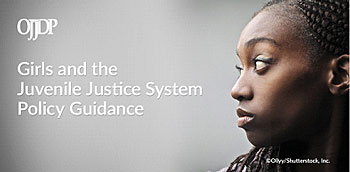 In response to the growing number of girls who end up in the juvenile justice system, often following incidents of sexual abuse or exploitation, OJJDP released a policy guidance on girls and the juvenile justice system in October 2015.
In response to the growing number of girls who end up in the juvenile justice system, often following incidents of sexual abuse or exploitation, OJJDP released a policy guidance on girls and the juvenile justice system in October 2015.
The guidance presents eight focus areas where states, tribes, and communities can improve their responses to girls. It also outlines OJJDP’s commitment to providing training and technical assistance, grants, research, and data collection support to enhance the juvenile justice field’s ability to better understand and meet the needs of girls.
Gender Injustice: System-Level Juvenile Justice Reforms for Girls, a report released by the National Crittenton Foundation in partnership with the National Women’s Law Center, presents research using OJJDP data which shows that, in the last two decades, girls’ share of the juvenile justice population has increased at all stages of the system. Key findings from the report show that between 1992 and 2013—
- Despite overall declining juvenile arrest rates, girls' share of juvenile arrests increased by 45 percent.
- Girls’ share of court caseloads increased 40 percent.
- Girls’ share of the detention population increased 40 percent.
- Girls’ share of the postadjudication probation poulation increased 44 percent and postadjudication placement population increased 42 percent.
To draw attention to the urgent needs of at-risk and system-involved girls, OJJDP participated in a number of events addressing the unique needs of this population.
On October 28, 2015, OJJDP Administrator Robert L. Listenbee and Senior Policy Advisor Catherine Pierce joined a panel presentation at a White House convening entitled “Girls of Color and Intervening Public Systems: Interrupting the Sexual Abuse to Prison Pipeline.” The “sexual abuse-to-prison pipeline” is the term used to capture the drift of girls into the juvenile justice system after they have experienced sexual abuse. As President Barack Obama noted in a September 2015 speech to the Congressional Black Caucus, “While boys face the school-to-prison pipeline, a lot of girls are facing a more sinister sexual abuse-to-prison pipeline.”
Experts at the White House convening included Roy Austin, Deputy Assistant to the President for Urban Affairs, Justice and Opportunity, White House Domestic Policy Council; D.J. Patil, U.S. Chief Data Scientist, White House Office of Science and Technology Policy; and Vanita Gupta, Principal Deputy Assistant Attorney General, Department of Justice. Discussion focused on ways to effect sustainable and systemic reforms that will dismantle the sexual abuse-to-prison pipeline and provide girls of color with better outcomes. Also telling their stories were three young women who had experienced sexual abuse and trauma as girls.
The effects of trauma on girls was also a key topic of discussion at the OJJDP-organized workshop, “Going Against the Grain: Addressing the Needs of System-Involved Girls,” at the Criminal Justice Coordinating Council’s Juvenile Justice Summit held in Washington, DC, on September 24–25, 2015. Administrator Listenbee, who participated in the workshop, stressed the need for trauma-informed care as an integral intervention strategy to help treat at-risk girls before they encounter the juvenile justice system.
OJJDP’s work on behalf of girls is ongoing. The National Girls’ Initiative, funded by OJJDP, plans to host a series of roundtables to identify emerging trends and develop strategies to address the policy and practice changes needed to divert girls and young women, including those who are involved in domestic violence cases, tribal youth, and young mothers. It also plans to develop an online training course that will be available via the OJJDP Online University.
Resources:
Download a copy of Girls and the Juvenile Justice System.
Read the executive summary of and access a comprehensive infographic from Gender Injustice: System-Level Juvenile Justice Reforms for Girls.
Learn more about OJJDP's research and programs regarding girls' delinquency on the Office’s website.
